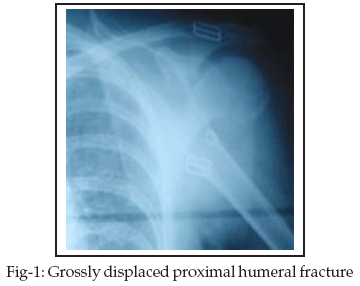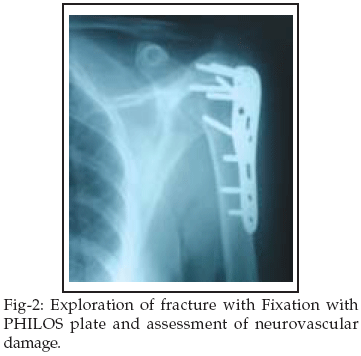|
|
||||
|
Published by : PROFESSIONAL MEDICAL PUBLICATIONS |
||||
|
ISSN 1681-715X |
||||
|
||||
|
- |
||||
|
CASE REPORT |
||||
|
- |
||||
|
Volume 24 |
July - September 2008 |
Number 4 |
||
|
|
||||
|
|
||||
|
|
||||
|
Published by : PROFESSIONAL MEDICAL PUBLICATIONS |
||||
|
ISSN 1681-715X |
||||
|
||||
|
- |
||||
|
CASE REPORT |
||||
|
- |
||||
|
Volume 24 |
July - September 2008 |
Number 4 |
||
|
|
||||
|
|
||||
Neurovascular Injuries following Displaced
Proximal Humerus Fractures:
Case Reports and Review of Literature
Mujeeeb Rohilla1, Ather Siddique2, Rehan Abbass Khan3
ABSTRACT
Displaced fractures of the proximal part of the humerus with injury of the brachial plexus are not very common. We present two cases of displaced proximal fracture of humerus with median nerve damage. Both the cases were having vascular injuries as well. One case had injury to profunda brachii artery which was ligated while the other presented with absent radial pulse.Neural injuries were treated conservatively with good functional results.
KEY WORDS: Neurovascular injuries, Proximal humerus fractures.
Pak J Med Sci July - September 2008 Vol. 24 No. 4 609-611
How to cite this article:
Rohilla M, Siddique A, Khan RA.Neurovascular Injuries following Displaced Proximal Humerus Fractures: Case Reports and Review of Literature. Pak J Med Sci 2008;24(4):609-11.
1. Mr. Mujeeb Rohilla, FRCS
Orthopaedic Registrar,
Department of Orthopaedics,
Our Lady of Lourdes Hospital,
Navan – Ireland.
2. Dr Ather Siddique, MBBS,
Orthopaedic SHO,
Mater University Hospital, Ireland.
3. Mr Rehan A Khan, FRCSI,
Assistant Professor, Department of Surgery,
Dow University of Health Sciences & Civil Hospital,
Karachi, Pakistan.
Correspondence
Mr. Mujeeb Rohilla,
Orthopaedic Registrar,
Department of Orthopaedics,
Our Lady of Lourdes Hospital,
Navan, Ireland.
Email: mujeeb_rohilla@yahoo.com
* Received for Publication: May 17, 2008
* Revision Received: July 19, 2008
* Revision Accepted: July 21, 2008
INTRODUCTION
Proximal humeral fractures are the second most common upper extremity fractures and the 3
rd most common fractures, after hip fractures and distal radius fractures in patients who are older than sixty-five years of age. Although the overwhelming majority of proximal humeral fractures are either non displaced or minimally displaced and can be treated with sling immobilization and physical therapy, approximately 20% of displaced proximal humeral fractures may benefit from operative treatment.Proximal humeral fractures are common injuries and represent approximately 5% of all fractures. These fractures are infrequently associated with neurovascular injuries. Neurological injuries are uncommon while vascular injuries are rare. A review of literature revealed that 84% of vascular injuries occurred in patients older than 50 years of age, 53% were associated with brachial plexus injuries, and 21% resulted in upper extremity amputation. The treatment is focused on preservation of hand function, which is more important than shoulder motion. Neurovascular damage causes an impairment of hand function. The priorities of treatment (reperfusion versus osteosynthesis) are dictated by the degree of ischemia. Long -term disability is determined by brachial plexus injury. Considering the close proximity between the proximal part of the humerus and the neurovascular bundle, it should not be surprising to see such injuries in displaced fractures of the proximal part of humerus.

Case-1:
A thirty-six year old, right hand dominant gentleman presented with a fall and sustained injury to his right shoulder and arm. Main presenting complaints were pain and swelling in right shoulder. Physical examination revealed neuroparexia in median nerve territory with weakness of long flexors and altered sensation in axillary nerve area. X-rays revealed a grossly displaced fracture of the proximal humerus with involvement of greater tuberosity (Fig-1). CT scan was performed to establish the full extent of the patient’s injuries. Patient was planned for open fixation. During the procedure, the profunda brachial artery was found to be completely severed, which was ligated. The median nerve was also found to be severely bruised. A PHILOS plate fixation of the displaced fracture humerus was done after reduction. (Fig-2) Postoperatively median nerve and axillary nerve sensations started improving and motor power in the flexors of the fingers was also increased. Patient regained full recovery in motor and sensory functions in three months.

Case-2:
A seventy year old, right hand dominant female presented with a fall and sustained injury to her left shoulder. She had reduced sensation in median nerve territory and had weakness of long flexors. Radial pulse was not palpable on left side. Axillary nerve sensations were intact. X-rays revealed a nasty communited fracture surgical neck humerus with fracture greater tuberosity of humerus Patient was planned for open fixation and brachial plexus exploration. Median nerve was found to be intact although extremely bruised. Axillary artery and vein were also found to be intact although they were found bruised. Adequate reduction was achieved under image intensifier and PHILOS plating of proximal humeral fracture was done. The fracture greater tuberosity was attached to the plates using an Ethibond stitch. Patient had good capillary refilling and circulation at the end of surgery. Loss of radial pulse was assumed to be because of pressure of fracture fragment. Median nerve injury recovered gradually with full recovery in two months.Discussion
Proximal humeral fractures occur most commonly in elderly persons.
1 Twenty one to 36% of proximal humeral fractures are associated with neurovascular injuries.2 Eight percent results in permanent motor loss. The axillary nerve is the most common nerve injured. The suprascapular, radial, medina and musculocutaneous nerves are also at risk. Proximal humeral fractures usually result from a fall onto an outstretched arm. In young adults, direct blows are a more common cause. Vascular lesions are infrequently associated with fractures of the proximal humerus. About 27% of axillary artery injuries may have palpable pulses due to scapular collateral circulation. Associated parasthesias and an enlarging mass must be viewed with caution. Most vascular injuries (84%) occur in patients older than 50 years.3,4 This increased incidence in elderly individuals occurs because falls are more common in this age group and atherosclerotic changes, which may make the vessels less pliable, predisposes these individuals to arterial injury.3Recovery of nerve injury and the corresponding loss of muscle strength occur in all patients; however, the duration of the recovery may be prolonged in cases with nerve lesions. Restoration of the function of the shoulder can be less favourable. It is important to realize that, in both conservative and operative treatment of proximal humeral fractures, a paresis due to nerve injury can affect the restoration of shoulder motions as well as hand function.
4 An electromyogram can be useful in the investigation of nerve lesions, because detection only by clinical examination proved to be very difficult.5 A number of mechanisms of injury to the neurovascular structures in proximal humerus fractures have been described, including direct injury to the neurovascular structures by the sharp bony fragments, stretching of the artery in hyperabduction, avulsion of the nerves and arteries at its origin and entrapment within the fracture site. Theoretically, arterial spasm is another cause of axillary artery occlusion,but true arterial spasm is exteremly rare. Diagnosing arterial spasm as the cause of arterial occlusion may lead to dangerous inactivity when limb threatening ischemia is present.6,7Vascular injuries associated with proximal humerus fractures is a rare occurrence but can have profound consequences. Distal pulses may be present despite significant injury to axillary artery. Paresthesias may be attributed to brachial plexus injury. For this reason a high level of suspicion is often necessary for diagnosis. Doplers or angiography will identify the level and often the type of vascular injury. It should be obtained when evidence of ischemia exists, pulse deficits are noted, a rapidly expanding haematoma is present, or there is progression of neurological symptoms
8,9 The long-term outcome of brachial plexus lesions is very poor and the role of exploratory surgery is indicated in all the cases. The long-term outcome of upper limb injury is not dependent on the vascular injury which can be successfully managed, but upon recognition, treatment, and outcome of the associated nerve injuries.5 Displaced fracture humerus either because of low velocity or high velocity injuries can be associated with neurovascular injuries. Neural injuries may need surgical approximation if completely severed and treated conservatively if bruised. It is always important to evaluate the radial pulse; its presence can be misleading in a case of vascular injury due to collateral circulation. Failure to recognize and treat these injuries can have catastrophic consequences. Early diagnosis and physiotherapy are recommended.REFERENCES
1. McManus F. Brachial plexus lesions complicating anterior fracture-dislocation of the shoulder joint. Injury 1976;8(1):63-6.
2. Shaw AD, Milne AA, Christie J, Jenkins AM, Murie JA, Ruckley CV. Vascular trauma of the upper limb and associated nerve injuries. Injury 1995;26(8):515-8.
3. Batey NR, Makin GS. Br Neurovascular traction injuries of the upper limb root. J Surg 1982;69(1):35-7.
4. de Laat EA, Visser CP, Coene LN, Pahlplatz PV, Tavy DL. Nerve lesions in primary shoulder dislocations and humeral neck fractures. A prospective clinical and EMG study. J Bone Joint Surg Br 1994;76(3):381-3
5. Visser CP, Coene LN, Brand R, Tavy DL. Nerve lesions in proximal humeral fractures. J Shoulder Elbow Surg 2001;10(5):421-7.
6. Drury JK, Scullion JE. Vascular complication of anterior dislocations of shoulder. Br J Surg 1980;6757981.
7. McLaughlin JA, Light R, Lustrin I. Axillary Artery Injury as a complication of proximal humeral fractures. J Shoulder Elbow Surgery 1998;7(3):292-4.
8. Paley D, Love TR, Malcolm BW. Bilateral anterior fracture dislocation of the shoulder with brachial plexus and axillary artery injury. Orthopaedic Review 1986;154436.
9. Sathyarup D, Juilgol AK, Iyer KM. Axillary Artery thrombosis following a fracture of the neck of the humerus. Injury 1988;1945-7.
HOME | SEARCH | CURRENT ISSUE | PAST ISSUES
Professional
Medical Publications
Room No. 522, 5th Floor, Panorama Centre
Building No. 2, P.O. Box 8766, Saddar, Karachi - Pakistan.
Phones : 5688791, 5689285 Fax : 5689860
pjms@pjms.com.pk